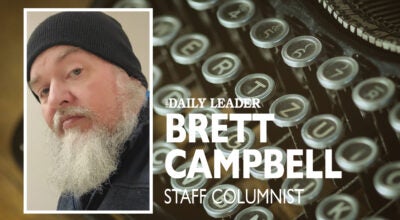Learning from Luther: 500 years of lessons
Published 9:46 pm Tuesday, October 24, 2017
David Misner’s classroom at Brookhaven’s VFW Post 2618 looks the part of a homeschool co-op. An American flag hangs in the corner, and tidy rows of metal folding chairs line up four to a table. Moms stand along the back wall. A seventh-grader digs through a BeDazzled backpack in search of a pencil.
The words on the whiteboard — post tenebras lux — aren’t par for the course, though, at least not most semesters. Believing this year’s 500th anniversary of the Protestant Reformation warranted something special, the co-op’s organizers hired Misner, a seminary graduate with an affinity for church history, to bring Martin Luther to life. And to explain Latin phrases.
“After darkness, light,” he calls out after an appropriate pause, and students hurry to scribble the definition in three-ring binders. It lands somewhere next to notes they’ve taken about big words like sacerdotalism and even bigger questions: How did Germany’s culture produce both a Luther and a Hitler? Are the five solas at risk today?
The Brookhaven co-op is just one of many educational settings across the country expanding this year’s teaching to mark the start of the Protestant Reformation. Students at the Ambrose School in Idaho are learning Luther’s hymns, including the well-known “A Mighty Fortress is Our God.” Choir members from California’s Aliso Niguel High School toured Wittenberg, Germany, this summer, tracing Luther’s steps. At Memphis’ Briarcrest School (featured in the movie, The Blind Side), art students were assigned 10 pages of Reformation research in their visual journals.
And two miles east of the Brookhaven co-op, students at Alexander Junior High School also have the opportunity to learn Reformation history. Luther, a champion of Christian education who wrote that he “would advise no one to send his child where the Holy Scriptures are not supreme,” might be surprised to find his posting of 95 theses makes the cut of Common Core knowledge. Several of his now-famous complaints are printed verbatim in the Holt McDougal World History book filling backpacks at Alexander.
While that traditional textbook’s approach to teaching the Reformation may rate four pages, the main idea highlighted among its large font and medieval illustrations is societal impact. Christian schools, on the other hand, tend to go heavy on the Reformation’s theological implications. The challenge for educators who wish to mark the true significance of 500 years of sola fide? Finding ways to communicate both.
I guess the educators in my life failed to do either. (Or maybe I just daydreamed through those classes.) The truth is, I didn’t have a clue who Martin Luther was (is he related to MLK Jr.?) until my mid-30s. That’s a shame.
It’s also a shame if we let the trappings of Halloween highjack what we should be noting this Tuesday. That’s right. October 31 is the big day — Reformation Day 2017. Five hundred years of positive, rippling effects on Protestantism, the religious affiliation so many of us claim to be clutching.
For Misner, a tennis pro who has used his 32-year career as a springboard for mentoring teens, the co-op class has provided a prime teaching opportunity. He’s introduced Roland Bainton’s classic Here I Stand to a new generation, and presented papal bulls to Baptists and Pentecostals.
“If students grasp the lessons of the Reformation, they’ll be better equipped to face today’s culture,” Misner maintains. “Luther’s courage to stand for the truth when he knew it would probably cost him his life is inspiring. He didn’t cop out for the sake of safety or security.”
Kim Henderson is a freelance writer. Contact her at kimhenderson319@gmail.com.





